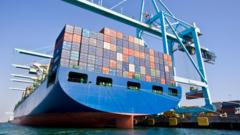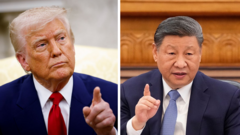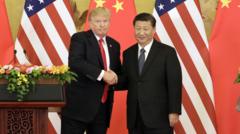The recent truce to cut tariffs between the US and China marks a pivotal moment in their trade relationship, with potential implications for global markets and ongoing negotiations.**
US-China Tariff Truce: What It Means for Global Trade Dynamics**

US-China Tariff Truce: What It Means for Global Trade Dynamics**
A new agreement between the US and China promises to lower import tariffs, signaling a significant reduction in trade tensions.**
The United States and China have reached a significant agreement to ease the tariffs imposed on goods traded between them, marking a notable step back from escalating trade tensions that have reverberated through the global economy. This truce, announced after high-stakes talks in Switzerland, signals a shift in the relationship between the two economic superpowers.
Under the newly agreed terms, both countries will lower tariffs that initially spiked during President Donald Trump's administration. The deal entails the cancellation of several tariffs entirely and a suspension of others for a period of 90 days, effective until May 14. Consequently, tariffs on Chinese imports to the US are set to reduce from an eye-watering 145% to 30%, while China will reduce tariffs on US goods from 125% to 10%. Additionally, China has abandoned some non-tariff barriers, including restrictions on the export of critical minerals to the US.
However, the deal retains some US measures aimed at compelling China to address illegal fentanyl trafficking, including a 20% tariff component dedicated to this issue. Following this announcement, economic analysts have cautiously welcomed the truce, highlighting that even if tariffs were reinstated after the 90-day period, they would remain significantly lower than before, with US tariffs rising to 54% and Chinese tariffs to 34%.
Moving forward, the future of US-China trade remains uncertain, as both sides have expressed the desire to avoid a complete economic decoupling. US Treasury Secretary Scott Bessent indicated that ongoing discussions are anticipated, suggesting potential for further agreements. The commerce ministry in China echoed this outlook, framing the accord as foundational for strengthened cooperation.
In terms of trade, the scale of goods exchanged between the two nations is substantial. The US principally exports soybeans, pharmaceuticals, and petroleum to China, while major imports include electronics and smartphones, notably the Apple iPhone. However, the trade balance heavily favors China—exporting $440 billion to the US while importing only $145 billion, a situation that has long been a point of contention for President Trump.
As the truce unfolds, both sides are likely to declare victories; however, analysis from experts indicates that the perception of the deal's success may vary. For many in China, the reduction of tariffs reflects a leverage shift in their favor, while the US will maintain that a 30% tariff still burdens Chinese imports. Moreover, economic forecasts suggest the easing of tariffs could significantly stimulate trade flows, leading to a rebound in shipping and logistics sectors.
While the truce represents a step towards cooperation, the road ahead remains fraught with challenges as both governments continue to negotiate the terms of their trade relationship. Thus, the evolving narrative of US-China relations will be closely monitored, not only for its domestic implications but also for its broader effects on global economic stability.
Under the newly agreed terms, both countries will lower tariffs that initially spiked during President Donald Trump's administration. The deal entails the cancellation of several tariffs entirely and a suspension of others for a period of 90 days, effective until May 14. Consequently, tariffs on Chinese imports to the US are set to reduce from an eye-watering 145% to 30%, while China will reduce tariffs on US goods from 125% to 10%. Additionally, China has abandoned some non-tariff barriers, including restrictions on the export of critical minerals to the US.
However, the deal retains some US measures aimed at compelling China to address illegal fentanyl trafficking, including a 20% tariff component dedicated to this issue. Following this announcement, economic analysts have cautiously welcomed the truce, highlighting that even if tariffs were reinstated after the 90-day period, they would remain significantly lower than before, with US tariffs rising to 54% and Chinese tariffs to 34%.
Moving forward, the future of US-China trade remains uncertain, as both sides have expressed the desire to avoid a complete economic decoupling. US Treasury Secretary Scott Bessent indicated that ongoing discussions are anticipated, suggesting potential for further agreements. The commerce ministry in China echoed this outlook, framing the accord as foundational for strengthened cooperation.
In terms of trade, the scale of goods exchanged between the two nations is substantial. The US principally exports soybeans, pharmaceuticals, and petroleum to China, while major imports include electronics and smartphones, notably the Apple iPhone. However, the trade balance heavily favors China—exporting $440 billion to the US while importing only $145 billion, a situation that has long been a point of contention for President Trump.
As the truce unfolds, both sides are likely to declare victories; however, analysis from experts indicates that the perception of the deal's success may vary. For many in China, the reduction of tariffs reflects a leverage shift in their favor, while the US will maintain that a 30% tariff still burdens Chinese imports. Moreover, economic forecasts suggest the easing of tariffs could significantly stimulate trade flows, leading to a rebound in shipping and logistics sectors.
While the truce represents a step towards cooperation, the road ahead remains fraught with challenges as both governments continue to negotiate the terms of their trade relationship. Thus, the evolving narrative of US-China relations will be closely monitored, not only for its domestic implications but also for its broader effects on global economic stability.






















